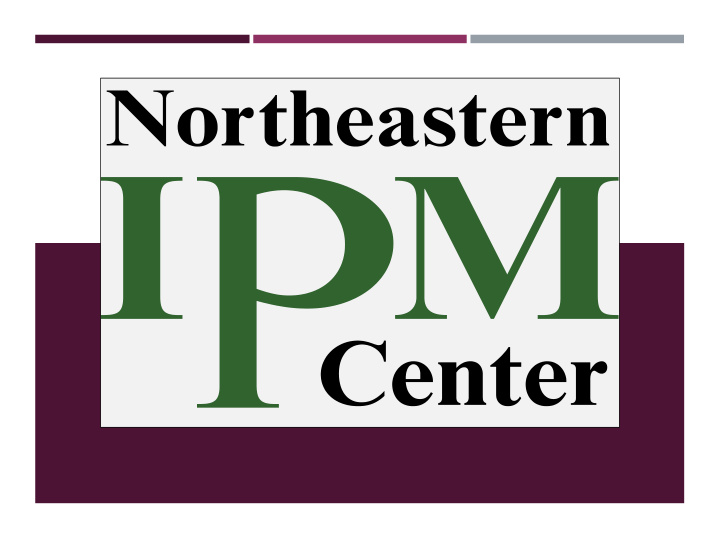



FULLY STAFFED AS OF SEPTEMBER 2018 New: Deborah G. Grantham, Director Mike Webb, Communication Specialist David Lane, Evaluation Specialist Continuing: Nancy Cusumano, Program/Extension Aide Jana Hexter, Grants and Partnerships Coordinator Susannah Reese, StopPests in Housing Program Coordinator Kevin Judd, Web Administrator
STOPPESTS IN HOUSING Number of Housing Sites Trained this year : 15 Total housing staff trained: 284 Total number of units represented: 32,355
STOPPESTS IN HOUSING IPM Training and T echnical Assistance Yields Cost-savings for Yearly pest control costs at two Public Housing ~600-unit housing authorities With training & technical assistance, $100,000 housing authorities are able to significantly $80,000 reduce the number of cases of bed bug infestation and the associated costs. $60,000 According to financial records, pest $40,000 control costs can be reduced by $60 per $20,000 unit by implementing an IPM program for bed bugs. This means a 600-unit public $0 housing authority can reduce their costs PHA 1 PHA 2 by approximately $36,000 per year, saving Pre-IPM Post-IPM a significant portion of their budget and providing healthier homes to residents.
BMSB Made significant updates to the StopBMSB.org website: Added a new biological control section with information about Trissolcus japonicas. Updated BMSB and T. japonicus maps. Added links to 36 presentations and 53 scientific publications. Kevin attended the BMSB IPM Working Group and Area-wide Stakeholder Meeting, November 2017. Currently developing researcher profiles and research summaries. Beginning to mine Google analytics for evaluation purposes. Recently reached out to Cornell Farm Workers Program to talk about that audience.
SPOTTED LANTERNFLY New StopSLF.org website in development. Nancy attended the first Spotted Lanternfly Working Group meeting July 2018 in Reading, PA. All presentations are at the Spotted Lanternfly Working Group page. NEIPM Center will be collaborating on the proposal to a soon-to-be released SCRI RFA. Julie Urban at Penn State is lead on the proposal, an outcome of the WG meeting. First planning meeting was October 10, 2018 .
COMMUNICATION Insights Newsletter Issues published in March and July, 2018 Additional issue underway by year-end Website Mobile friendly Rotating bi-weekly stories from funded projects in our region
COMPETITIVE GRANTS PROGRAM Grants program offering $250,000 in funding through 3 RFAs Issues: focuses on research IPM Working Group: focuses on establishing collaborations Communications: focuses on communicating science to the public Funds available in all five signature programs Welcome Webinar for new grantees
FACILITATING IPM INTERACTIONS Annual NEIPMC Online Conference to share research results (tentative Fall 2018) 5 minute updates from PDs (NEIPMC, NESARE, ARDP , EIP) Collaboration and awareness IPM T oolbox Webinar Series to share practical IPM tools (Spring/Fall) Find-A-Colleague Webpage to facilitate collaboration
OUTPUTS From the Pollinator Working Group: Bees and their Habitats in Four New England States (50 page printed Report) http://www.northeastipm.org/ipm-in-action/publications/bees- and-their-habitats-in-four-new-england-states/
EVALUATION Evaluation specialist collaborating with counterparts at other Regional Centers Using National IPM Roadmap Goals as guide Reviewing each project report Contacting PDs – is implementation occurring? Standardizing metrics – Common Measures/all Centers Identifying outputs, outcomes, and impacts
EVALUATION Determine project type (research, extension, or integrated) Articulate impacts and identify the most critical challenges related to adoption and implementation of IPM Assess Center’s impact: in contrast to evaluating each project – looking at effect of all the projects/efforts how much coordination, collaboration, communication, and increased implementation of IPM practices has resulted Assess return on investment of the Center’s efforts: leveraged funds, for example Parameters such as state, crop, setting, and type of pest from Website (Google Analytics) # of visits, unique visitors, downloads, views of videos
UPCOMING EVENTS Virtual meeting of Advisory Council October 31, 2018 Continued virtual meetings every 2 – 3 months BMSB meetings in November and February On-line conference Joint NEERA/State IPM Programs meeting Spring, 2019 at College Park, MD
QUESTIONS?
Recommend
More recommend